Nomadic Plants
Posted in: Uncategorized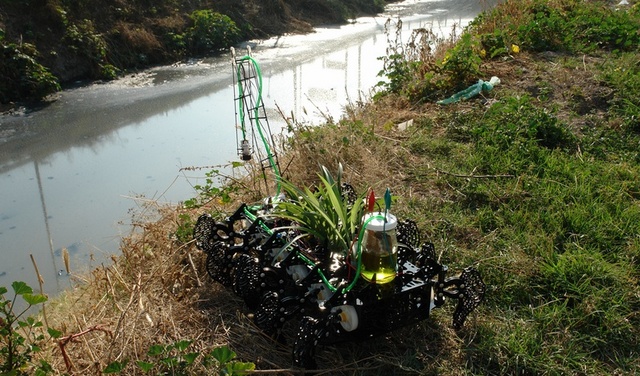

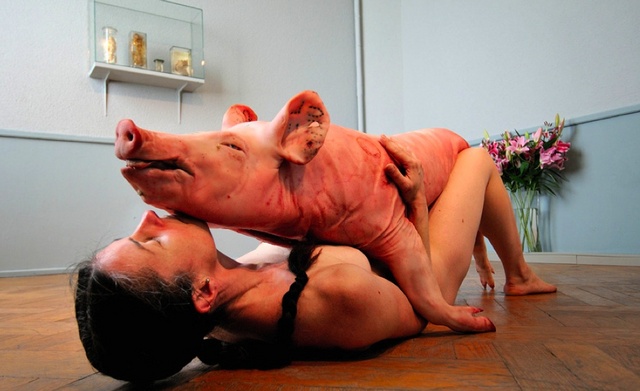
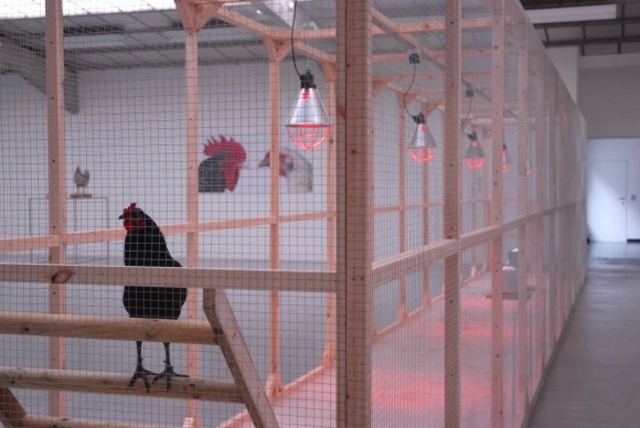
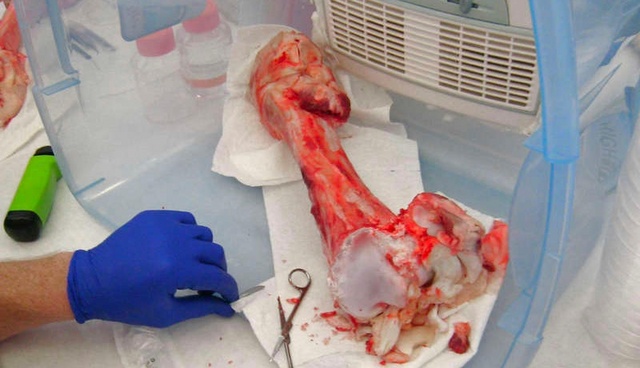
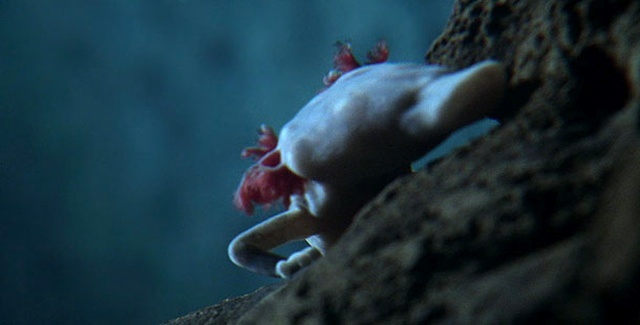
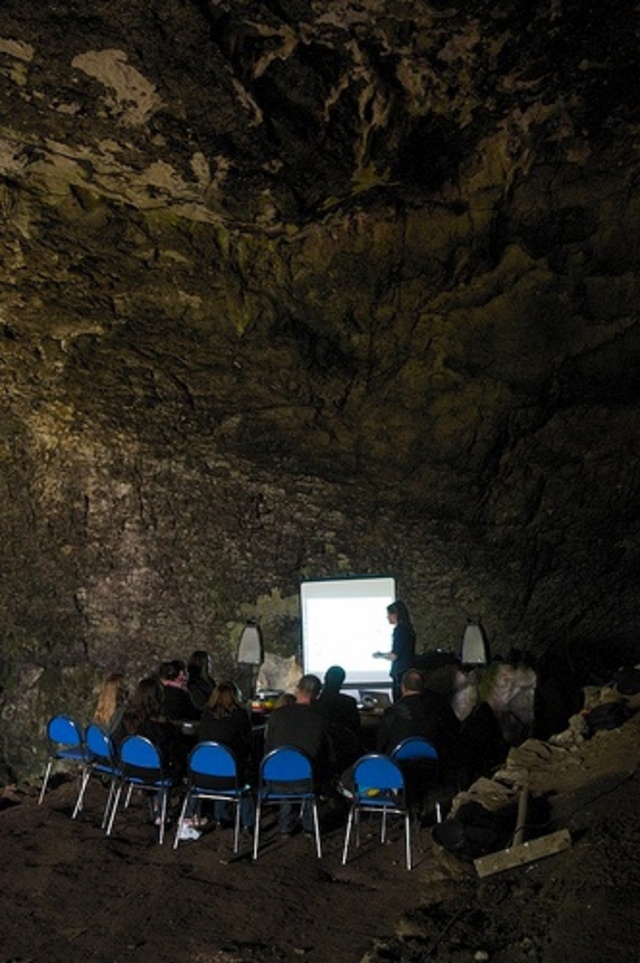
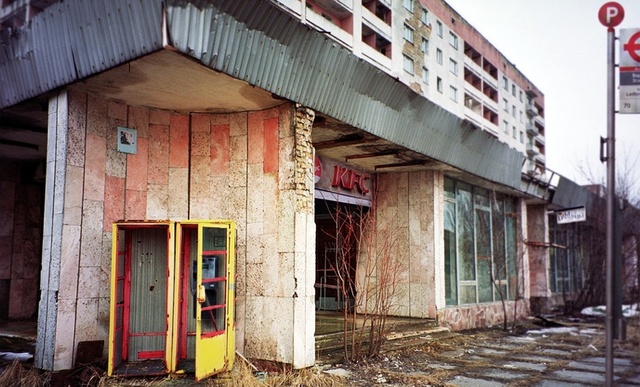
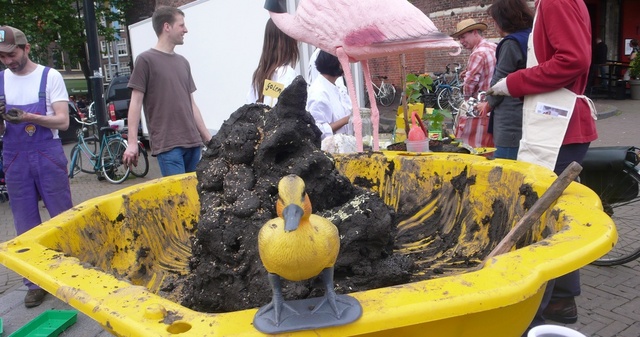
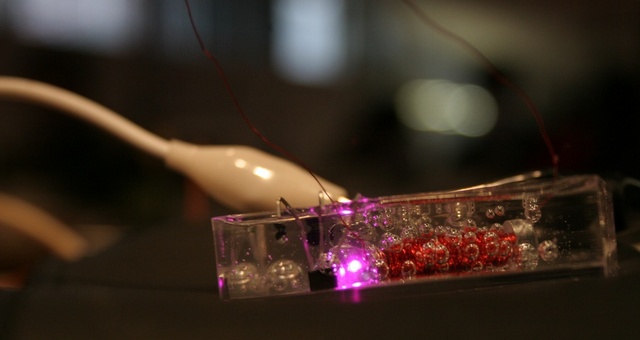
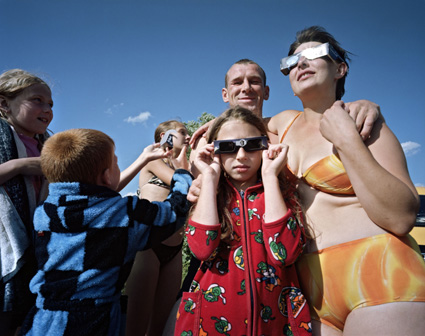
Group of Russians admiring the eclipse in the beach of Pervomaiskoje, Altai Krai, the locality where Tommi Taipale arrived on the eclipse day on his Journey to the Eclipse. Photo credit: Tommi Taipale
Last Summer, curatorial research group Capsula embarked on the first of its Curated Expeditions, demonstrating in the process that you don’t need an intergalactic spaceship to uncover new territories and make meaningful discoveries. This series of Curated Expeditions are research trips that engage with earthly phenomena through artistic investigation.
The 1st Expedition of Capsula invited 3 artists to observe a total solar eclipse which took place on August 1st over a vast area stretching from Canada, through to Russia, Mongolia and China. The observation location selected is the scientific Zoo in Novosibirsk, the capital of Siberia. Eclipse started in Novosibirsk at 17.45 pm.
The artists, German Agnes Meyer-Brandis, Catalan Mireia C. Saladrigues collaborated with the Zoo personnel and other experts to study the celestial phenomena and its impact on the animals and the visitors of the Zoo while Finnish photographer Tommi Taipale focused his work on the cultural and geographical distance between of Finland and Siberia.
Because Capsula’s latest focus is the relation between art and biology and environmental culture, the expeditions go hand in hand with a more leisurely and sometimes old-fashioned Philosophy of Voyage: walking, bob-sleighing, swimming, hitchhiking, rowing, sailing, trains and submarines. The travel from Finland to Novosibirsk took several days: While Tommi chose to hitch-hike, curator Ulla Taipale, Agnes Meyer-Brandis and Mireia C. Saladrigues spent three days to get there by train, taking the romantic-sounding Trans-Siberian Line.
With a background in Environmental Engineering and and Communications, Ulla Taipale is one of the founders and the current head of Capsula. I asked her to give us more details about this first curated expedition to Siberia:
Can you present us Capsula briefly? When and how it was born? What are its objectives?
 Capsula was founded by Mónica Bello Bugallo and Ulla Taipale in 2005 in Barcelona. It is a platform that creates cultural content and curatorial projects dealing with art, science and nature. The first project of Capsula was Days of Bioart in 2006. The event was a combination of a bioart seminar and SymbioticA Tissue Engineering and Art – workshop and organized in Centro de Arte Santa Mónica and in a laboratory of faculty of biology of Universidad de Barcelona. The cross-disciplinary approach has been characteristic of Capsula`s work from the beginning. In recent years Capsula has collaborated with cultural institutions such as CCCB (Centre for Contemporary Culture of Barcelona) and Intermediae in El Matadero of Madrid, DRU-Digital Reserch Unit of Huddersfield, among others, and have brought to these events many of the leading creators and researchers in the field of art, science and/or technology, such as Critical Art Ensemble, Tissue Culture & Art Project, Andy Gracie, Natalie Jeremijenko, Vandana Shiva, Jens Hauser, Ramon Guardans and Eugene Thacker, to name a few. The objective is to create interdisciplinary projects related with art&science, with a special attention on the natural and artificial environments.
Capsula was founded by Mónica Bello Bugallo and Ulla Taipale in 2005 in Barcelona. It is a platform that creates cultural content and curatorial projects dealing with art, science and nature. The first project of Capsula was Days of Bioart in 2006. The event was a combination of a bioart seminar and SymbioticA Tissue Engineering and Art – workshop and organized in Centro de Arte Santa Mónica and in a laboratory of faculty of biology of Universidad de Barcelona. The cross-disciplinary approach has been characteristic of Capsula`s work from the beginning. In recent years Capsula has collaborated with cultural institutions such as CCCB (Centre for Contemporary Culture of Barcelona) and Intermediae in El Matadero of Madrid, DRU-Digital Reserch Unit of Huddersfield, among others, and have brought to these events many of the leading creators and researchers in the field of art, science and/or technology, such as Critical Art Ensemble, Tissue Culture & Art Project, Andy Gracie, Natalie Jeremijenko, Vandana Shiva, Jens Hauser, Ramon Guardans and Eugene Thacker, to name a few. The objective is to create interdisciplinary projects related with art&science, with a special attention on the natural and artificial environments.
The last project of Capsula, called Curated Expeditions, was launched almost one year ago. The project is dedicated to observing and experiencing fascinating natural phenomena through the work of artists, scientists and other cultural agents. It also wants to revive leisurely traveling experiences, which have almost been cast aside by the frantic pace of modern day life. The first expedition was carried out last summer in Russia to explore and study the total solar eclipse and animal behaviour during this celestial phenomenon. This was realized through the proposals of German media artist Agnes Meyer-Brandis and Catalonian visual artist Mireia C. Saladrigues. On the other hand the expedition of Finnish photographer Tommi Taipale focused on the cultural and geographical distance between of Finland and Siberia during his journey to the eclipse by hitch-hiking. The project was done in collaboration with Novosibirsk Zoo in Siberia and with several other institutions, mentioned in the end of the interview.
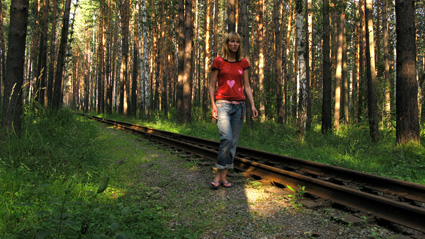
Ulla Taipale wandering in the vast forest by the Novosibirsk Zoo. Photo credit: Ulla Taipale
Curated Expeditions is a long-term project. Can you explain what are its long-term goals?
The object is to make a series of expeditions dealing with earthly phenomena in remote and nearby destinations . The aim is to stimulate production and exhibition of multidisciplinary artistic creation related with nature’s spectacles. I have many ideas for new expeditions and for the targets of the artistic survey, but these plans are in an early stage and not ready to be published yet.
Through these projects I want to give the protagonism to the natural phenomenon and promote positive emotions that can be experienced in natural and artificial environments. The question is: Could the natural phenomenon and the spectacles of the nature still fascinate a major quantity of people in the modern world, saturated by entertainment like video games and action movies? And, could these splendid and thrilling emotions lived within the nature, shift the attitude of people to more respectful and caring direction concerning their environment? Generally speaking, conservationism and environmentalism seem to be related with obligations and rejections that limit the level of life causing bad conscience. Sustainable way of life is related with low quality life – without luxury. I expect that the outcome of the expeditions – singular artworks, exhibitions, public debates and writings address towards to the enriching experiences reducing a distant and unconcerned attitude when thinking about nature and our relationship with it.
So, to name some of the more tangible goals – maybe in five years and after several expeditions a publication will be made out of these projects. And the new artworks created are to be exhibited in traditional and non-conventional spaces. I would also like to gather interesting people, not necessarily experts, but persons with good ideas to discuss publicly the issues indicated by the expeditions. The idea is to break categorizations and frontiers between different disciplines.
Curated Expeditions explored a phenomenon which lasted 2 minutes and 20 seconds. Yet you deliberately traveled using relatively slow and old-fashioned ways. You, Agnes, and Mireia took an almost 3 day train ride from Helsinki to Novosibirsk, while it took Tommi a whole week to get there by hitch-hiking. Why was it so important to undertake a long journey when (apparently) you didn’t have to?
Curated Expeditions wants to revive leisurely traveling experiences that personify the Capsula Philosophy of Voyage. Walking, bob-sleighing, swimming, hitchhiking, rowing, sailing, trains and submarines, just to name a few, are means of transport that permit your soul to arrive to the destiny simultaneously with your body. No matter if the destiny for the artistic exploration of the natural phenomenon is near or far, the participants should be aware of the distance and the differences- cultural and geographical ones – between of the departure and arrival.
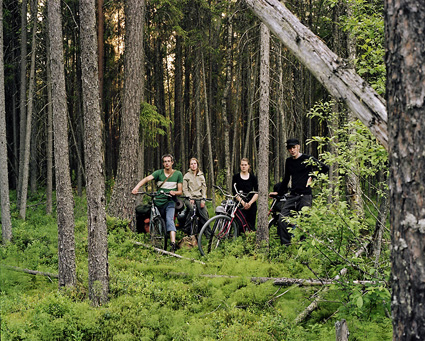
Tommi Taipale, Siiri Anttila, Selja Eskonen and Heikki Tuorila cycling in Russia. Photo credit: Tommi Taipale
We didn´t have to spend three days on the way and also it would have been less expensive and troublesome to take a direct flight to Novosibirsk. Many people warned us telling about uncomfortable and dangerous trains, we were asked several times why not to travel flying, that Russian people were noisy, in the summer the wagons would be hot and in general very inconvenient for three women with a lot of luggage. I have to admit, that I was questioning the decision many times. Also buying the tickets for exact days and routes was not easy at all because of Russian bureaucracy, holiday season and the mass movement of eclipse tourists. But, at the end we were in Helsinki railway-station with our huge luggage – Agnes was carrying 60 kilos on her – and the journey could start.
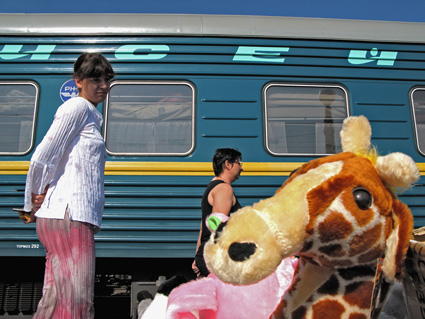
A break in a station on the Russian Trans-Siberian railway. Photo credit: Ulla Taipale
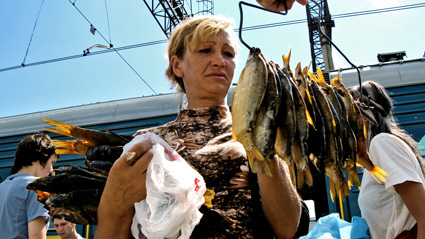
Russian train passanger selects fish, offered by “babuskas”, local grandmothers sell in railway-stations. Photo credit: Ulla Taipale
Once in the train, we did forget our doubts! During the three days between Helsinki and Novosibirsk we were able to learn some Russian, to know Russians, to know each other on a more personal level, converse, read books, watch the changing scenery from the window and while enabled and disconnected from the internet, got slowly into the mood of Capsula Expedition. And once we arrived, we were sad to leave our temporal itinerant home, the Russian co-travelers, the samovar and the rhythmic sound of the train.
Coming to Tommi, he spent two weeks on the road to get to Novosibirsk. As an experienced Russian traveler and wanderer, he could estimate roughly how long time it would take to get from place to another. During the first days he traveled with three friends using recycled bicycles and then alone towards to the tundra by hitch-hiking and using some river-boats. This extra round to the northern part of Russia was his attempt to escape the heat – the summer in Russia was hot, during July – August the daily temperatures rose up to 30ºC almost every day. However, even in Salehard it was sweaty!
Hitchhiking in Russia is a very common way to travel. To get a hitch is not difficult and a lonely Finn on the road wakens curiosity and hospitality in Russians – often he was offered also a place to sleep on the way.
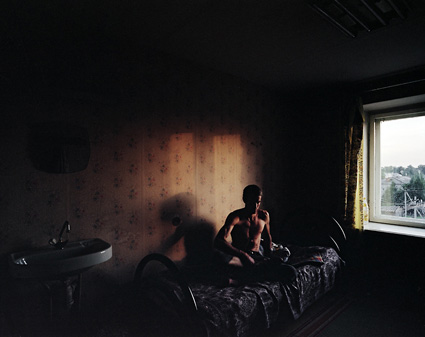
Tommi Taipale in a hotel room in Nikolsk, on his way to the total eclipse. Photo credit: Tommi Taipale
Tommi´s photographs reflect his meetings with ordinary people that can be found traveling alone leisurely in a strange territory. He has a basic Russian knowledge that allows him to connect with people who coincide with his fortuitous way that doesn’t respect timetables. His pictures open doors to the everyday life of Russians showing what often remains behind of the topics of the country, such as the life habits of the of class of new rich, the alcoholism and poverty, and the country’s military and energy power. In these glimpses shown in Tommi´s pictures a grandmother offers a lonely traveler sweet tomatoes or cranberries, a mine worker invites him to take a bath in a banja, Russian sauna or a group of silent men waiting for a river-boat in the dawn.
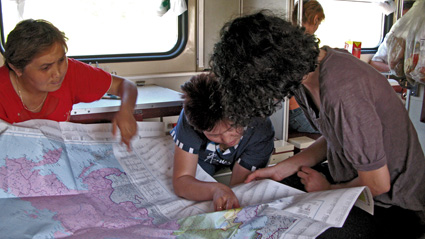
Mireia C. Saladrigues studies Russian map with Kirgisian co-travellers in the Trans-Siberian wagon. Photo credit: Ulla Taipale
By the way, is a journey on the Trans-Siberia as romantic as it sounds?
To our surprise it was big pleasure, nicer than we could ever imagine. You can do it more comfortably with a bigger budget in a higher class, having a daily shower and your own toilet, but then you might miss the contact with the co-travelers and a part of the taste of adventure. And the official Russian time, that shows Moscow hour where ever the train is in Russia, makes your daily rhythm disappear – instead of looking at your watch to start eating and sleeping, you let your state of mind or energy levels decide what to do. Our public relations and Russian language rehearsals always got more interesting and intensive the nearer we got to Novosibirsk. During the last hours in the train, Mireia found the first volunteer, a Russian girl to work with her in the project in Novosibirsk. Something very characteristic for Mireia´s work, which is based on her interpersonal skills and communication with people.
Anyway, I have to admit that we three adapt well to tough conditions. Traveling in Russian trains is good as long as you don’t except too comfortable a life and are not too prejudiced.
The zoo of Novosibirsk in Siberia seems to be a very intriguing place. How did you get to know about its existence? How did the owners and workers of the zoo welcome a bunch of artists keen on mingling with their animals?
When the decision to start the Curated Expeditions project by investigating a solar eclipse was taken, I started a closer study of the zone of totality, that was a vast area from Alaska, Siberia and Mongolia to China.
In 1999 I experienced my first solar eclipse in Hungary, in a small village of Rapabatona by the Danube, where I cycled from Vienna. I was astonished by the reaction of animals, mostly birds and insects, during the eclipse. So, when I found out that the biggest and oldest Zoological Park of Russia was situated in Novosibirsk, just in the middle of the eclipse zone, I decided to focus the project on the animal behaviour during the eclipse. The negotiations with the Zoo started and after weeks of correspondence and phone calls they agreed to collaborate.
We were made very welcomed. Sveta, the secretary of the Zoo, came to pick us up from the railway-station, and took us to our new home. We were invited to stay in an apartment situated in the Zoo area that is normally used by foreign zoologists and researchers visiting the Zoo. Novosibirsk Zoo Park is huge. The area consists of 53 hectares of pine forest and it is a home for around 12 000 animals and 634 species. Bengal tigers and snow leopards are among the 120 endangered species represented in the Zoo that can be found in the Red Book. Our neighbours and their numerous different ways of sonic communication filled the air with roaring, yelling and howling, especially in the dusk and dawn. Our communication with zoo workers was possible thanks to Sveta and Maria, Siberian English literature students, who were the links between us, the zoo workers and the journalists. English is rarely spoken in Russia, but the young people start to be stronger in languages than their parents who did their studies during the Soviet time.
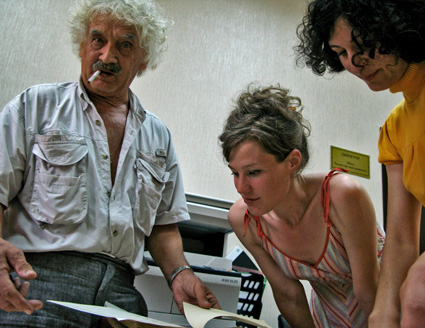
Agnes Meyer-Brandis and Mireia C. Saladrigues study notes from the year 1981´s annular eclipse animal behavior with the Zoo director Rostislaw Shilo.Photo credit: Ulla Taipale
We presented our intentions to the director Rostislaw Shilo, who runs the Zoo with 40 years of experience. Him and his wife, the scientific director Olga Shilo, are highly liked and respected personalities in Novosibirsk and people from taxi-drivers to biologists have positive things to say about them. In parallel with running the biggest Zoo in Russia and his scientific work, Rostislaw Shilo is also a Siberian eco politician, influencing environmental issues from the parliament of Siberia. Once we explained the goals of the expedition he didn’t hesitate in supporting the project. Not only did he offer us nice accommodation for nine days, but also helped us further in achieving rare moon geese for Agnes´ experiment and in gaining visibility in the Siberian media, among other things. We are very grateful for his and the all zoo personnel support, they were very generous and shared their knowledge with pleasure.
Russians are quite reserved and it is hard to know what the animal caretakers and other personnel really thought about our visit, but after breaking the ice they were more than cordial.
Some of the projects, in particular the one of Mireia C. Saladriques involved the participation of the public. How did it go? What happened?
Mireia´s project, called Zoolar Eclipse was fully realized within the installations of the zoo. Zoolar Eclipse investigated animal reactions when the darkness, caused by the total eclipse, suddenly fell into the Zoo. Not only the volunteer zoo visitors participated in her work, but she also got very connected with some of the animal caretakers despite the language barrier. During our stay in the Zoo she was following a daily program to observe and study through drawing the animals selected. The animals were selected following her own intuition and advice given by Dr. Sabater Pi, Catalonian ethologist and primatologist, and the director of the Zoo of Helsinki, Seppo Turunen. The final selection consisted of white-handed gibbon, eagle owl, liger, yellow-throated marten and polar bear. Liger, one of the main crowd-pullers of the Zoo, is a hybrid cross between of male African lion and a tigress. She also participated in animal´s feeding and daily routines with zoo personnel. Mireia woke up with the sun around five or six o´clock in the morning to realise her first walk by the animals with her pens and sketch book, then again between four and six o´clock (the eclipse hour) and the days were completed by the last round at sunset. Through these observations and interviews with the zoo personnel she wanted to learn the habitual behavior of the animals during the different positions of the sun.
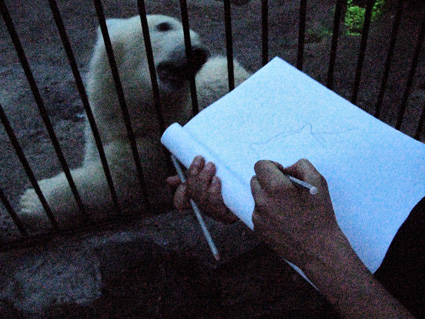
MIreia C. Saladrigues drawing a polar bear in a semi dark Zoo Park. Photo credit: Ulla Taipale
At first we were worried about not finding enough people to take part in the survey. These concerns disappeared once in Novosibirsk. On a normal summer day the Zoo counted more than 10 000 visitors. The news about this special opportunity spread also through the seven biggest TV-news of Siberia that interviewed us and the invitation to participate in the project circulated around through television, radio, city forum in internet and by Mireia´s posters in the Zoo.
On the actual eclipse day, Mireia and ten Russian volunteers delivered and recollected the Zoolar Eclipse postcards for and from one hundred zoo visitors, interested in writing their impressions of the effects of the sudden disappearance of the sun. She herself decided to observe the gibbons. In the moment of eclipse, she says, the role of the one that in the zoo normally is observed – the gibbon – changed and these primates were the ones that observed the humans, totally excited, yelling and shouting as apes in a state of climax.
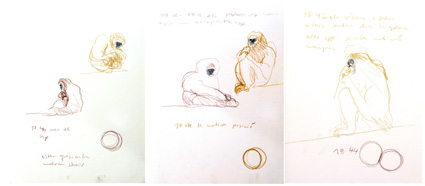
During the totalirity, Mireia C. Saladrigues chose the white-handed gibbons of Zoo as the object of her observation, due to their similarity with the humans. The drawings explain their activities during the eclipse. Image credit, Mireia C. Saladrigues
The texts by zoo visitors are now being translated from russian to finnish, english and to spanish and the contents seem to be quite touching and subjective. People have interpreted the behavior of animals in very different ways. The writings describe also strange physiological changes in the observers themselves, such as headache, dizziness, extreme feelings of happiness and even sudden hunger. The texts will be available on the website of Capsula Expeditions once they have been completed in english.
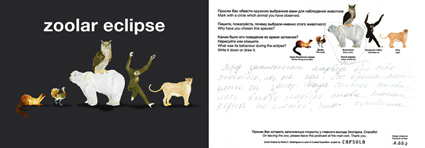
A postcard by Mireia C. Saladrigues and the written observations by a Novosibirsk Zoo visitor. Image credit, Mireia C. Saladrigues
While Mireia´s work took place in semi-artificial surroundings inhabited by wild animals, Agnes moved special Moon Geese to a natural setting to realise her bio-poetic investigation. The Moon Goose Experiment is based on a text by english bishop Francis Godwin and was published first in 1638 in the book called “The Man in the Moone”. The geese of Godwin`s novel fly to the Moon instead of heading to the South in autumn. Would that be something that could happen for some species of migrating birds soon, as an consequence of the search for more suitable habitats than a polluted planet Earth, facing the effects of climatic chaos?
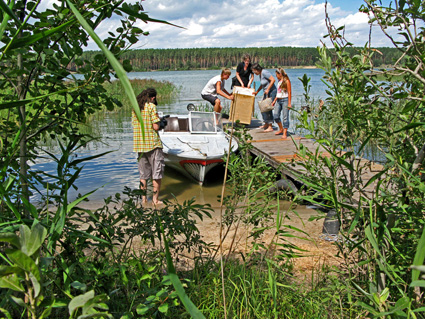
Arrival on the Sacred Scarabeus island, where the Moon Goose Experiment was carried out. Agnes Meyer-Brandis and Alexandra Deribas unload the moon flight equipment. Photo credit, Ulla Taipale
To find the required thirteen suitable Moon Geese and a runway for a moon flight in beautiful natural surroundings was an adventure, and only the determination of Agnes made this possible. Despite the fact that geese are protagonists of her work, also here the local people were playing a very important role in helping to carry out the plan. With the collaboration of Novosibirsk assistants we experienced unforgettable moments in a russian datsa, a typical small farmhouse with all kind of domestic animals, and on a sand island that was chosen to be the experiment scenery. This datsa was situated near to the Academgorodok, the Soviet époque’s ambitious science city project.
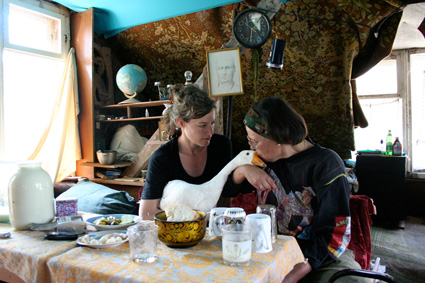
Agnes Meyer Brandis and Alexandra Deribas during geese training in Moon Goose Home, “Datsa” (little farm) of Alexandra and Gennardy Deribas near Akademgorodok, Novosibirsk. Photo credit Agnes Meyer Brandis
The actual Experiment was brought to fruition on that small sandy island “Sacred Scarabeus” in Ob River, an hours´ drive away from Novosibirsk centre. The Moon Goose Experiment crew arrived there early in the morning, on the 1st of August, to prepare the flight equipment and do all the necessary preparations. At 17.45 local time, we had the chance to witness a historical takeoff by Ljuba, a young Russian astronaut, and her moon flight in the darkness, provoked by the total solar eclipse. You can find a detailed report of the day on Agnes´web page.
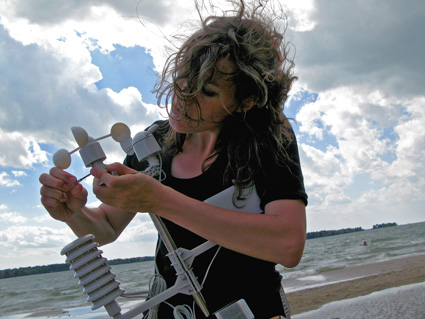
Agnes Meyer-Brandis is fixing pieces of the weather station in the Scarabeus island in SIberia. The sky was cloudy and and the wind was blowing almost 14 m/s just an hour before the total eclipse. Photo credit, Ulla Taipale
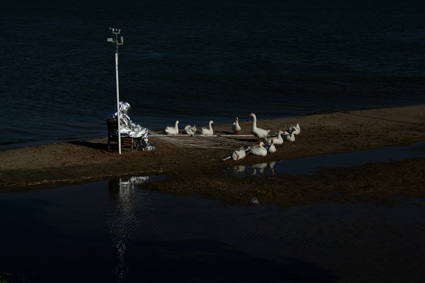
After the first touch, contact of moon and sun at 16.45, the geese stayed calm and Luba, the parachutist got ready for the Moon flight. Image: Agnes Meyer-Brandis
What can artists bring to the vision and experience of natural phenomenon which have already been widely studied by scientists?
A scientist follows his/hers paths of research and an artist his/hers, and both can achieve surprising findings in the same object of investigation. In the end, Curated Expeditions is not trying to gain results that would have scientific importance. The objective is to bring together artists and scientists to work at the intersection of different disciplines, but the results are art works and don’t have to contribute to scientific studies about natural phenomena. What I would like them to contribute is to the recognition of small and big miracles of nature and consciousness about its extraordinariness.
I like the way that Ian McKeever, the english artist, describes the work of scientific and artistic researcher in his text from “Ikijää – Permafrost” (edited by Marketta Seppälä and Yrjö Haila) :
At the moment all us “expeditioners” are “unzipping” the material gathered during the journey- photographs, drawings, videos, writings, and impressions that we lived during this cross-disciplinary expedition. Little by little the final artworks and the ways to present the fruits of the expedition are taking form, the reflections and ideas get processed in our minds. The three proposals were materialized and they are now in progress, the end is not determined.
Talking about visions, I would be very content, if, inspired by these and future proposals, the audience would let their imagination fly a bit further and travel along the migrating birds in the sky to new, surprising destinies, and, instead of purchasing a low cost flight to do shopping in a nearby European country someone would take his bicycle and see what adventures can be lived in the next village. These are some examples of different thinking that the artists could bring to our techno-scientific society where even natural phenomena is tried to be explained and reasoned.
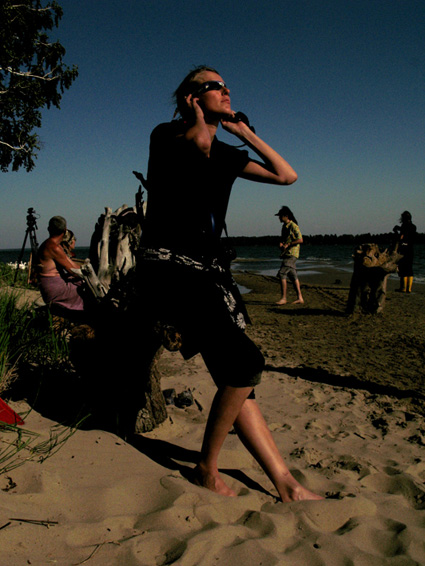
Ulla Taipale in Siberian Scarabeus island, in the strange light during the moment of totality, that lasted 2 minutes 20 seconds, at 17.45 pm. Image Capsula, author unknown
Now that you are back from these adventures, which conclusions do you draw from the experience? What did you learn from the first curated expedition?
It is extremely hard to work with a tiny budget in a country where you don´t know the language and have to depend on many volunteers help. But it is really rewarding when suddenly you discover a bunch of people who are willing and motivated to help you and share the vision that has inspired you to go so far. We can´t thank enough of all the people who helped us in Novosibirsk and during the year to prepare everything. The success of the project was depending on their collaboration. The next expeditions hopefully have bigger budget, but, at the same time I would love to be able to collaborate with local people where ever these projects will happen. Sometimes big resources cause certain distance to the place where you go, the production is taken care of by a professional crew and personal contacts with ordinary people of the locality are lacking. That can be extremely called “cultural colonialism”. I wish to continue Curated Expeditions with the possibility to experience these real meetings with local people.
Despite certain difficulties during the preparation phase of the projects, the artists have shown big talent, imagination and capacity of improvisation to get everything ready for the 1st August when the solar total eclipse happened.
What are Capsula’s upcoming projects?
The Moon Goose Experiment, Zoolar Eclipse and The Journey to the Eclipse will be shown for the first time in Helsinki, Finland, in March 2009, in the Museum of Contemporary Art Kiasma. The show is called “Expedition to the Total Eclipse” and organised as a part of Pixelache09 Festival activities that will consist of an exhibition, (from 6th March until 7th June, 2009), a seminar and some extra activities in the astronomical observatory of URSA. I am invited to stay as a resident in HIAP production residency during February and live in a fortress island Suomenlinna, close to Helsinki centre.
The second Curated Expedition, that will be related to the Baltic Sea, is being maturated at the moment and Capsula is also involved in activities that the Finnish Society of Bioart is organising in Kilpisjärvi Biological Station in Lapland during 2009. Their focus is in arctic biology, climatic and environmental changes and their artistic exploration. The news of Capsula will be published on the website and through the blog.
The next total solar eclipse will occur in India and China in 22nd July, 2009.
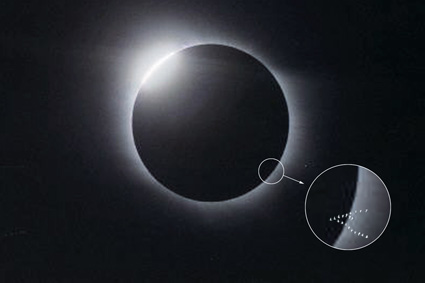
Rare Moon Geese are getting close to the Moon during the total eclipse. Image credit: Agnes Meyer-Brandis
Capsula´s Curated Expedition has received support from:
Zoo of Novosibirsk, FRAME Finnish Fund for Art Exchange, AECID (Agencia Española de Cooperación Internacional para el Desarrollo), VR (Finnish Railways), Venäjän ja Itä-Euroopan Instituutti (The Institute for Russia and Eastern Europe), Finnish Embassy in Moscow, Generalkonsulat der Bundesrepublik Deutschland in Nowosibirsk (General Consulate of the Federal Republic of Germany in Novosibirsk), A MINIMA magazine, Agrupación Astronómica de Sabadell (Spain), AirBerlin, Helsinki University – Kilpisjärvi Biological Station (Finland), University of Art & Design, Pori Department (Finland) , ARPI – professional photostore (Barcelona), NCCA Ekaterinburg (National Centre for Contemporanean Art, Russia), Colección Sabater Pi (Barcelona), Korkeasaari Zoo (Helsinki), SAS Royal Hotel (Helsinki), Sodexo Oy / Hostel Satakuntatalo (Helsinki), Antares Ltd (Barcelona), Fire Department Cologne, Tesimax (Germany), HMKV Dortmund
The exhibition “Expedition to the total eclipse” has received support from:
Pixelache09, Kiasma, HIAP (Helsinki International Artist-in-residence Programme), AVEK (The Promotion Centre for Audiovisual Culture in Finland), Taiteen Keskustoimikunta (Finnish Art Council)
Special thanks for Anneli Ojala from The Institute for Russia and Eastern Europe for translating the Zoolar Eclipse postcards in Finnish!
Thanks Ulla!
I can’t think of any artist who manages to outdo Adam Zaretsky in the art of combining a somewhat comical approach with a keen reflection on the legal, ethical and social implications of new biotechnological materials and methods.
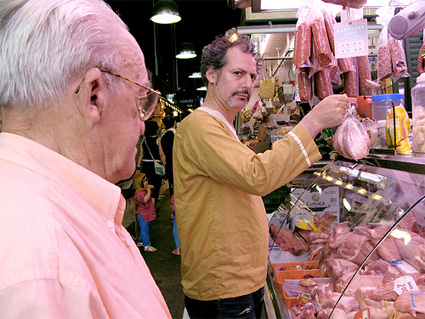
Adam Zaretsky buys a pig heart at the Boqueria food market in Barcelona. Image credit, Capsula
Zarestsky has co-habited during one week in a terrarium with E. Coli bacteria, worms, plant, fish, frogs, mice, flies and the lovely yeast. He has dedicated part of his research at the Massachusetts Institute of Technology to paying Engelbert Humperdinck‘s Greatest Hits to fermenting E.Coli continuously for 48 hours and observing the impact the music had on the bacteria. In case you’ve never heard of this romantic singer, let me spoil your day with a video of one of his smashing melodies:
Zaretsky is a a bioartist, performer, researcher and art theorist whose work focuses on Biology and Art Wet Lab Practice. He has been lecturing and doing research in some of the most prestigious institutes around the world, including the MIT’s Department of Biology, the Conceptual/Information Arts department at San Francisco State University, SymbioticA at The University of Western Australia and at the Rensselaer Polytechnic Institute in the Integrated Electronic Arts Department.
As you might remember, Zaretsky teaches Vivoarts, an emerging and politically charged field that brings together art and biology, at the University of Leiden (NL.) The Vivoarts: Biology and Art Studio course explores the intersection between art and biology and discusses the many cultural issues involved in bioart -and more generally in the field of life sciences- through a blend of hands-on laboratory protocols, critical readings, and the production of contemporary artwork. The ethics of producing living art are debated and made more tangible and understandable by the use of living material/organisms into the class final projects.
I posted it last year already but in case you haven’t seen it yet, here’s ‘Dangerous Liaisons’, a short documentary on his class at Leiden University:
Zaretsky believes that we should “embrace our visceral and experimental mutant kindred. Life is not perfectionism. Life includes the open, onanistic and seemingly unacceptable faces of radical variation.” As he states:
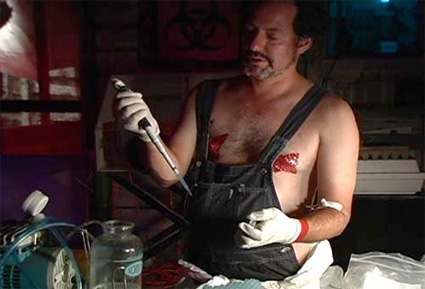
powerFARM :: Woodstock, NY. Adding DMSO for Crypreservation. Still from video
I had the pleasure to share panels with Adam Zaretsky several times. The most recent was Media Art in the Age of Transgenics, Cloning, and Genomics, an event that the lovely rhizome people had invited me to curate. Now that i’ve finally recovered from the surprise he made us by starting his presentation with an extract from a biotech porn video he was working on, i feel that it is high time to 1. invent an opportunity to share another glorious event with him somewhere on this planet before it implodes 2. blog an online Q & A i had with him so that you can get to know him better. I focused this short interview on the work he has been doing in The Netherlands.
The experiments you describe in the video took place in the context of an avian embryology lab for non-scientists at Leiden University. How much knowledge did the participants have of biotech before they entered the lab room? What was their background? Does it take a long time before they can ‘get their hands’ into the genome?
The VivoArts : Art and Biology Studio Honors Class at Leiden was the first of its kind in the Netherlands. Since my class another Art and Biology Course has been taught at Leiden U. by Jennifer Willet and in April the third version will be taught by Caitlin Berrigan starting spring 2009 (so sign up now.)
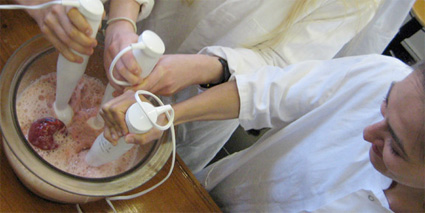
DNA extraction in class. Image
Thanks go out to Prof. dr. Robert Zwijnenberg of The Arts and Genomics Centre for investing time and brave direction to make these courses a reality and for organizing the breadth of disciplines being exposed to this sort of Bioethics Art Practice. The participants were from Art History, Sociology, Philosophy, Biology and even Theology… But, there is no Art Studio practice degree at Leiden U. so we put out the word and a few artists applied or just showed up.
The simple answer to your first question is, no experience is necessary. All Vivoarts labs are hands on labs for the untrained. I guess it’s a sort of biology brut or outsider biology. Informed opinions on present-day and near-future bioethical conundrums are more readily coaxed out of non-biologists through a hands on approach. It takes time to get approval to teach non-professionals and students whose focus is not biology or bioethics. After clearance, the students can come in with zero experience and leave having made time-based, hybrid, new media, wet-lab, living arts pieces: transgenic embryo sculptures, GMO bacterial paintings and/or tissue cultured embryonic stem cell totemic fetish objects.
There were some reticent parties on campus. They claimed that they were worried their patients might be afraid that artists a la Moreau were treating them. (…) I think that the reaction to an art class in the lab doing ‘important’ transgenic embryology work in the name of non-utilitarian, ‘frivolous’ artistry reflects a fear of demystification of transgenic process. Is the fear of attention given to playful transgenic embryological research procedures limited to wariness to contend with animal rights advocates often knee-jerk responses? Or, is it because often enough, well-funded Transgenesis research is as equally ‘useless’ or has just as little chance of producing important data as a hands-on Transgenic Developmental Biology Embryological Sculpting Lab for Social Commentary. But, these balkers are University researchers. Why hide from eager students in a castle of learning? Transgenic human production is a contentious cultural issue that is in need of interdisciplinary research before it goes to market. If we want an informed public to help us gauge the eventual results of aesthetic human engineering, we need people with experience who have their own ideas about the process, the results and the price of genetic tinkering.
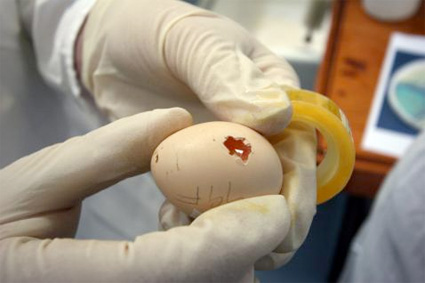
Photo from the Transgenic Pheasant Embryology Lab, credits to Jennifer Willet from Bioteknica
You mention in some of the written documents that plasmid injections were made with homemade tools. Hackers and amateurs around the world are experimenting with technology in a creative way as part of a broad DIY culture. Do you think that this DIY approach could apply to biotech art experimentations like the ones you perform? Where are the limits?
About half of my labs are 100% DIY. A lot of the Art and Biology crew are interested in the demystification of technology. The dorkbot skillshare mentality is more than a hot geek dating service. It’s about showing that the technology, in this case biotechnology, is comprehensible and actuate-able with home brew strategies and some kitchen sterile technique.
For instance, the microinjectors for our embryology lab were made of glass pipettes pulled over a flame into small-bore needles. The plasmid was literally sucked up and hand pressed into the living embryos. We squirted into the embryos. The hope was that the microinjection needles were smaller than the embryonic nuclei and that, without microscopes, the plasmid would be injected or find its way into some nuclei for incorporation into the genome of the unborn pheasants.
This is not how an embryologist would work. The odds of success are already low without such haphazard application technique. Expensive machines are used to pull glass needles of the exact bore which will penetrate the nuclei of the organism of choice (mouse, rat, human, frog or fly embryos for instance.) Injections ‘usually’ occur through the microscope and XYZ microcontrollers guide the payload into the organism with finesse and acuity. Microinjectors cost over 100,000 euro and are not usually available to the general public (although I did use one at MIT to inject wasabi and cream cheese into Tobiko.
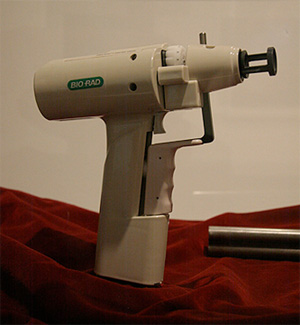 But less accurate methods like gene guns or direct injection of DNA are also used in today’s gene therapy trials. These human trials, which may be producing germline alterations, emphasize the porousness of our collective genome. The history of embryology is built on cheap contraptions and closet incubators. Look at chicken breeders, both their social status and their successes. How many of them used strange feed or other ‘pushing of life’ techniques to make their prizewinning mutants?
But less accurate methods like gene guns or direct injection of DNA are also used in today’s gene therapy trials. These human trials, which may be producing germline alterations, emphasize the porousness of our collective genome. The history of embryology is built on cheap contraptions and closet incubators. Look at chicken breeders, both their social status and their successes. How many of them used strange feed or other ‘pushing of life’ techniques to make their prizewinning mutants?
So, I would say that persistence will outweigh the technological edge especially because no one has any idea of what life is, what the future holds and what the long term effects of even supposedly ‘controlled’ experiments will have on ecology, living being and the concept of species integrity. As far as I can tell, a tattoo gun with a single point needle dipped in the right plasmid concoction might be a great nano-transfectant for the lotek-biotech artist who still likes to draw. If it takes a lot of microinjections to get success when working blind… then gene tattooing is the way to go. (You could also buy a cheap microscope and improve your odds at least 30X.)
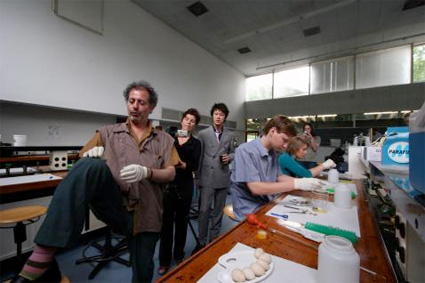
Photos from the Transgenic Pheasant Embryology Lab, credits to Jennifer Willet from Bioteknica
(Warning: Gene insertion may eventually cure cancer but right now it can also cause cancer. (i.e. Leukemia, see the case of Jesse Gelsinger).
Now, when it comes to DNA sequencing and plasmid design, this is just starting to be a tabletop possibility with cheaper sequencers and biobrick sets from the megaMaterialists over in Synthetic Biology. But, the learning curve is steep and can be expensive if you don’t want to work with ready-mades. Designing your future pet’s body plan or your own prehensile tail or an extra brain in your lovely daughter’s derriere… that will take some trial and error. The effect is not just material. The genes are multifactorial. We haven’t a clue as to what metabolism is. We can’t even distinguish between enhancement and a living curse. But still, I’m hopeful.
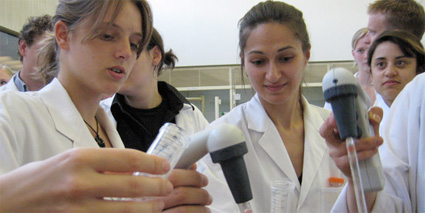
DNA extraction in class. Image
The lab obviously triggered many questions and debates. One of them drew a thought-provoking parallel between animal research and animal sacrifice, a pratique which nowadays seems outdated and almost barbarian. I know that you are careful to comply with legal limits and are deeply concerned with the ethics of what you are doing and preaching. But did you mention this parallel between sacrifice and research in order to highlight the more sinister aspects of research? What are the most sobresalient points of the research/sacrifice debate that took place among the participants of your class?
First I wrote this:
Funerals Rites for Transgenic Pheasants: Rituals of Bio-Art Practice
Some artists are utilizing lab technique as a new medium to produce living and often mutant living art forms. As these ‘sculptures’ live and die, often at the whims of the artistic investigator, the personal, non-repeatable moments take on a ritual air. What kinds of rituals do interdisciplinary Art and Biology practices entail? How do they reveal the implicit rituals of science? What new performative rites come out of mixing ethics and esthetics in the laboratory? Scientists also have their methodologies of creative flourish and humane sacrifice. But, scientific and artistic play is often based on different paradigms of what the act of experimentation is. As artists learn laboratory technique, the rituals of science and new rituals of sci-art unfold, decouple and reconfirm magical thinking in both arenas. How does animal research relate to the history of animal sacrifice? What is the role of subjectivity in developmental embryology? Is transgenic protocol also a ritual for the cultural production of liminal monsters? And how does mutagenesis impede or coerce the imaginary in the lifeworld? Through an analysis of artists confronted with the responsibility of ending the life of transgenic pheasant embryos, (which they had altered with plasmids in the name of art,) I hope to show living rituals for new biotechnological processes as they are invented.
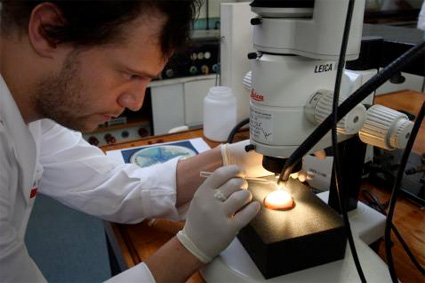
Photos from the Transgenic Pheasant Embryology Lab, credits to Jennifer Willet from Bioteknica
But to be more down to earth, this is complicated and needs regular talk too. First of all the students were guaranteed a good grade even if they choose to be ethical observers. So there was no pressure to be hands on. Secondly, methods of humane sacrifice were discussed even if the concept is an oxymoron. Legally, embryonic birds are not organisms in Europe. What they really are is unclassifiable, but they are not free living nor do they have fully developed nervous systems. So they are conceived to be dim or not fully on. They may be thought of as a group of cells on the way to becoming a full-fledged, free-living organism. For this reason, they do not have rights in any way nor do they have a single preferred humane sacrifice method. Actually, humane sacrifice is not a prerequisite in embryonic end of life issues.
Of the scientists I quizzed, the methods of sacrifice commonly applied were death by: autoclave, refrigeration, put down on ice or poured down the drain. I added to other options for my students: valium overdose or ritual sacrifice. The valium overdose was my idea of the most humane sacrifice for an embryo. It may have been the first time that an embryo was given such a respectful euthanasia. But, the ritual sacrifice option was wide open and I can tell you that we are still living in barbaric times.
Also, I offered to play executioner for my students. Often I had to not just respect their choices but enact them. It was a horrific part of the lab for me. But, I did learn a lot. I wouldn’t dismiss the value of sacrifice in science, religion or even secular posthumanism. Some rituals were moving funerals about the traumatic pasts of the slayers. Some underscored visions of techno-obliteration, the War Machine (Critical Art Ensemble, see the first chapter of The Flesh Machine), which accounts for way too much of the world’s economic and productive focus. Some of them were heartless and natural and sincere. One student’s acts even inspired remorse for outsourcing an incineration. It is as if serial killing and bureaucracy were still strange bedfellows. All and all, the sacrifices were conducted in a responsible way even if they were non-utilitarian. The lab showed the range of human behavior when dealing with GMO snuff issues and unborn politics and it gave experience of the viscerality of transgenic process to the students.
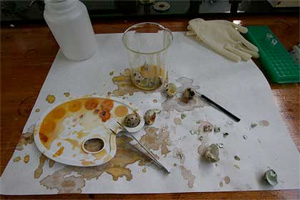 Photo from the Transgenic Pheasant Embryology Lab, credits to Jennifer Willet from Bioteknica
Photo from the Transgenic Pheasant Embryology Lab, credits to Jennifer Willet from Bioteknica
To be quite frank and honest, I am still in a strange state of being torn around these issues. I think abortion should be legal and believe in a woman’s right to choose. Yet, I believe in embryonic isness: that there is something dignified about a developing organism. I am anti-war and think capital punishment should be abolished. I support some animal research as I have seen results that do help with disease. I do think the focus should be on AIDS and Malaria instead of prostate cancer and new cholesterol blockers. But it is not that simple. Often enough, I approve of experimental curiosity in general. I understand that we have a strange human gymnastic need to scope and poke everything to see how it ‘ticks’ or even just as pornography. I do think most biological research is just in-group magical empiricism but I also think that it is effective in a social cohesive sense. So, I guess I am old fashioned when it comes to ritual sacrifice even with a lab coat shaman behind the lab doors. Nonetheless, we humans could be less nationalist and provide global food, shelter, clean water, free rent and a ‘work-optional’ baseline to all humans. And, if you believe the news, many Bioart practitioners, myself included, lay claim to a sort of relational bent, attempting to go beyond anthropocentrism in the name of respect for the non-human actants of the earth. That is, many of us do consider all life to have an existential specialty which is their own and which is often superior to Homo sapiens narcissism in diverse ways of niche working and play. Yes, if we have it in us, we need to give back a lot of the land mass we have ‘cultivated’ on the crust of this planet to non-humans for their rights to freedom, space and daytime walks. But when it comes to embryos, I admit, I eat bunches of them on a weekly basis: caviar, eggs, raw seeds, grain, and bean sprouts. Being alive is a sort of hypocritical stance.
We cannot apologize to the organisms we use, even our flowers after death, because I doubt they would accept an apology. We cannot thank them, as some of the native peoples of the Americas still do, for providing us dinner or art materials, because I doubt they would say ‘you were welcome.’ In a sort of Taoist or Fatalist sense, we can try to welcome the hunger of the living consumers of our living and hence dying bodies (whether they be human, other animal, vegetable, bacterial, insectoid, fruity or fungal) as they come to feast on our inevitable temporary-ness, our becoming food for others. For this reason, I am anti-embalming and believe in green burials as we are just mulch in the long-term sense. In the short term we are entropic, greedy, sensual, hungry holes in need of sustainable release through passionate spectacle. (see my video Retool Earth.)
I often refer to this type of trial by fire lab as a Milgram Experiment without authority. I proclaim myself an amateur, I give the option to not participate and yet, when given the legal thumbs up, most people will do what they know is ethically tarnished. At the same time, fear of implication in the lifeworld, shame of causing death in general, while causing death, is more dangerous than modern primitivism. The Nobility of Neurosis (J.G. Ballard re/Search) is part and parcel to the Latourian concept of modern distinction as a farce. So, although I wish the Hague War Crimes Tribunal had authority over the nation I live in which has no respect for the Geneva Convention, the Nurenberg Code or the Declaration of Helsinki, fertile eggs are still a popular food particularly in green non-vegan circles. A well-made fertile egg omelette is no casual funereal ritual. Baroque and gourmet productions take time and the nuance and the taste is not lost on the pallete.
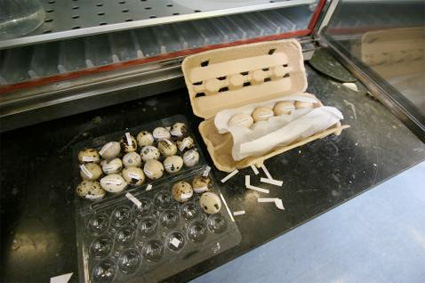
Just to underscore that I am thinking while acting the clown…
The fertile eggs were named during incubation. This is a list of their names:
Health, Beauty, Longevity, Public Good, Knowledge, Profit, Erotism, Utility, Novelty, Animal, Poor, Queer, Captive, Slave, Fat, Ugly, Short, Stupid, Primitive, Unborn, Deformed, Poor in the World, Raw Material, Extinguish Humanely, Expendable Being, Educational Embryo, Pity Party, Defect, Murder Me, Loss and Lack, Death Row, Dead End, Destiny, Non-Being, Non-Human, Sub-Human, Pre-Human, Ancestor Rape, Use Me, Material, Fratricide, Torture Mirror, Somatic Machine, Responsive Behavior, Model Organism, Reflex Entity, Workhorse and Factory.
One of your documents mention a project in Spain? Why Spain? And where exactly would you like to perform new researches? Can you tell us briefly what this project would be about?
Actually, I talked to Marta de Menezes of Ectopia in Portugal (another Bioart Residency to look into) and she said that Bull Fights, the Politics of Primitive Tradition versus the Elimination of any Appearance of Injustice and Bull Sperm Sorting for Breeder Profit (transgenic as all hell) were all popular pastimes in Spain. So if I was in Spain or Portugal, I might like to look for some off target mutations in the garbage bin of a major Bull Sperm Sorting outpost. Really, the FACS Bucket text was just an idea for a residency that ended up getting published in Portugal. Due to parenting responsibilities, I can’t spend more than two or three months a year outside of the US. The WAAG Society and The Mondriaan Foundation have decided to host/sponsor a public course and performance over the next year in Amsterdam. I would also like to work on making more transgenic pheasant embryos so I can fine tune my imaging and maybe even discover something that might make a reductionist out of my otherwise sticky fingers. I am looking for more funding so send money people to Lucas Evers
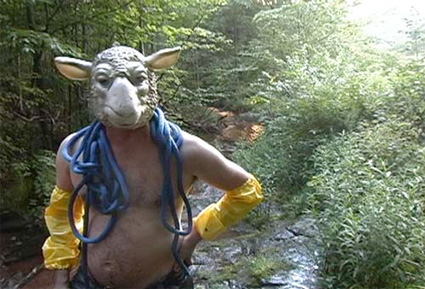
pSHEEP, screenshot from pFARM
Right now, I live in the Catskill Mountains of New York, Woodstock, USA. I am gearing up to initiate VASTAL: The VivoArts School for Transgenic Aesthetics Ltd. I would prefer it function independently of any university so it would be obscure, DIY and edgy. But this would need a real budget even for a two-year planned obsolescence trip. I also consider pFARM to be conceptually ready to make the move to something more than a small collective. The Organic Biotech Fetish Farm has started to attract devotees and as a cult grows, so must its infrastructure. We are still accepting applicants on subservient grassroots level at this time. Although I have traveled widely, I ask myself which other nation is there that deserves the kind of lessons I mete out. I can smell the Ku Klux Klan hay in every corner of the world markets but the USA has taken Superpower-Slumlord to a new low. So, I figure New York is my tropical island in which to experiment with human volunteers and their gonads… VASTAL 2010 … Know any strange hosts?
I wish i did. Thanks Adam!
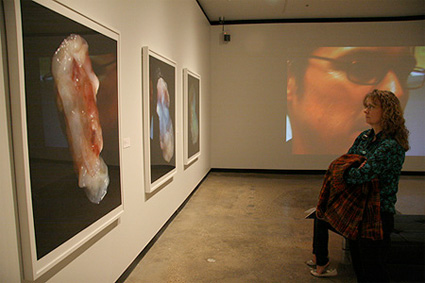
Transgenic embryo prints as exhibited at Imagining Science Exhibition, Art Gallery of Alberta, 2008-2009
In the news: Adam Zarestky is participating to the show Imagining Science that runs through February 1, 2009 at the Art Gallery of Alberta. Zaretsky and The pFARM Collective are part of the exhibition Corpus Extremus which opens in February 2009 at Exit Art in NYc. The book Imagining Science: Art, Science, and Social Change has won an award in the 2009 New York Book Show in the Scholarly & Professional category.
From what i can learn from the press we are living in food mayhem: yesterday morning a nutritionist was complaining on French tv that because the country had turned its back on the usual bread and jam breakfast in favour of American-style fat and sugar-loaded cereals, the population was at risk of fattening. In the afternoon, i was reading in La Repubblica that the soaring costs of pasta, bread, fruit and vegetables are making Mediterranean diet harder to afford. Italians are eating more cheap processed foods high in fat, sugar and salt (via WSJ.) The whole continent is complaining about the food crisis. Meanwhile, bananas are dying, eating local might not always be that energy-efficient after all and a livestock meltdown is under way across Africa, Asia and Latin America. An alarming report states that native breeds are increasingly being supplanted by Western farm animals, which may be less well able to adapt to their new environment in times of drought or disease. In Europe, some 98 per cent of vegetable varieties have disappeared over the past century and EU regulations are hastening the decline.
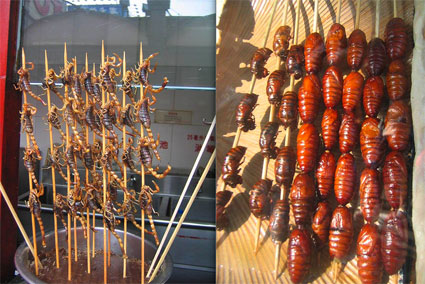
Yummy healthy insecty snack seen in the streets of Beijing
Mind you, researchers have devised new but rather unappealing ways to have us enjoy food like never before: fish are being trained to catch themselves, we’ll be able to choose between meat from cloned animals and in vitro meat and encouraged to get better proteins by snacking on insects.
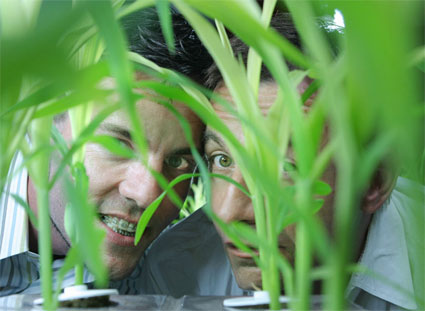
Matias Viegener and David Burns have added the corn issue on the table.
You might know them for their ongoing collaboration with Austin Young: Fallen Fruit, a project which encourage people not only to map “public fruit”, fruit which grew on private trees and fell on public spaces, but also to harvest and plant fruit parks in under-utilized areas.
Back in 2004, Matias and David worked on an installation which i discovered only recently. That year, Fritz Haeg (of the Edible Estates fame) and Francois Perrin produced and curated the GardenLAb experiment. Set in a 1942 supersonic wind tunnel, the event explored the relationship Los Angeles residents have with their environment by experimenting and speculating on current and future ecologies.
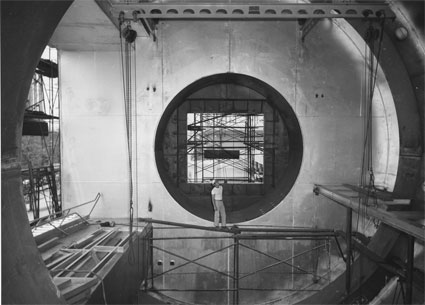
The “Coop Wind Tunnel”
Corn Study humourously addresses the future of human food production and the ongoing consequences of issues that range from the latest developments in genetic manipulation, mistreatment of plants and animal species, corporate control and profit motivation, diminishing genetic diversity, modification of our ecosystem, privatization of ownership of plant’s genome, etc.
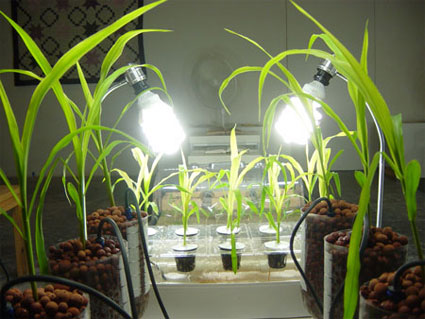
Corn Study, detail (Figure 0038), 2004. Photography Austin Young
One of Corn Study’s objectives was to develop a new relationship with the corn species.
Through the use of audio and autosuggestion the artists deployed Aldous Huxley‘s theories of hypnopedia: the most powerful educational device being unconscious suggestion to the embryo to maximize its developmental potential.
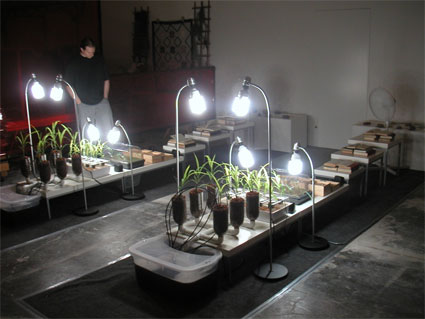
The school is set up on ten tabletops with different learning stations, with the corn seeds learning through audio speakers as well as by the use of electric fans behind a row of books, which carry knowledge through the air like pollen. In this program of accelerated learning, the individual kernel is not expected to learn everything — the species as a whole will absorb the knowledge collectively. The variety of knowledge bases is hoped to heighten the corn’s wisdom, especially since despite their enormous acquisition of knowledge, humans have acquired so little wisdom.
As the artists conclude in their presentation of the project: While it may take many generations before the outcome of our experiment can be demonstrated, we are hoping for positive mutations and raised consciousness in the corn, to be passed along to other species. At this stage of global development, humans can no longer be entrusted with full stewardship of the environment. Perhaps if other species can intervene, they will do a better job.
I asked Matias and David to tell me more about the school for corn species:
We’ve been hearing and reading about genetic manipulation for years now. I sometimes think that consumers got used to it, accepted the idea and wouldn’t mind buying and eating GMO (or even cloned meat when it lands in our supermarket fridges.)
What exactly should we be worried about? What is different in the new forms of manipulations Corn Study comments on?
While we were interested in genetic manipulation we wanted to work away from it. The basis of Corn Study was the idea that corn had been studied and manipulated more than any other plant than perhaps soybeans. While we’re disinclined to GM foods, it seems clear that all our agricultural foods have been manipulated for millennia. So we wanted to refocus the question of GM foods into the broader question of how humans have studied and changed our foods without any seeming consideration for the nature (or the education) of the foods themselves. What if we could give the corn some agency of its own, educating it about its human hosts. Our ironic goal was to find a way for the corn to gain some power over its own fate, to “speak out” if it could, by learning more about us and both the good and the bad of the human universe.
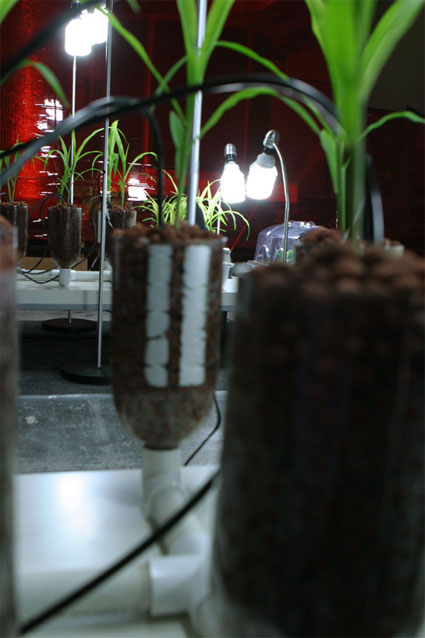
What does corn education involves exactly? Could you guide us through the whole curriculum?
While there was a lot of specific material, there was no defined curriculum for the corn school. Or maybe a better way to say this is that we could have endlessly kept adding educational material to the school. Here’s a quote from the original text that was distributed to visitors:
“The curriculum is composed of texts, lectures and readings in political science, history, psychology, philosophy, foreign languages and cultural studies; we have tried to select materials that help outline the background of our global socioeconomic, political and environmental circumstances. For the student’s personal growth we include tapes on self-actualization, meditation, hypno-suggestion, and personal dynamics. The songs are mostly pop music from the 60’s and 70’s, chosen to reflect the optimism of a time now fallen by the wayside. Included in our coursework are Noam Chomsky, Friedrich Nietzsche, Marxist theory, Mahatma Ghandi, Winston Churchill, Neil Armstrong, Machiavelli, Plato, Immanuel Kant, Abraham Lincoln, Anthony Robbins, Brian Tracy, Zig Ziglar, Lao Tzu, Gloria Steinem, Elizabeth Vandiver, greek myths, Howard Zinn, Ken Wilber, Malcolm x, Michael Moore, Ralph Nader, Lyndon B. Johnson, Al Sharpton, Terence McKenna, Aldous Huxley, Paul Scheele, Michael Pollan, Henry Thoreau, various international Pimsleur language audiobooks, The New Christie Minstrels, Melanie, Paul Williams, Ray Charles, The Carpenters, Cher, Three Dog Night, The 5th Dimension, Donovan, Bread, Dolly Parton, Jefferson Airplane, Sly and the Family Stone, the Doors, and John Denver.”
Do you welcome both “natural” and modified corns in your classes? Is there any segregation?
We welcomed all corn to the school, including GM corn. We tried for a good mix of modern hybrids and ancient or “heirloom” corn varieties. We don’t think one group is in any way superior to the others. The idea was to empower the species as a whole to make collective decisions and perhaps take actions to both improve their lot in the world and deflect any more human mismanagement of it. Halfway through the design we realized that all seeds of all species should be welcomed to the school, without distinction between crops and weeds, the good or the bad, which are all values that come from humans and not from nature itself.
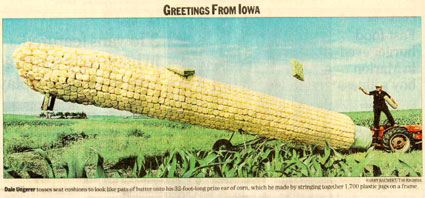
Giant Iowa corn
Why did you choose to work with corn? Wouldn’t animals seem like a more natural and rewarding choice?
We worked with corn because of the place it holds in American culture. Americans consume more corn products than any other nationality (and in recent years corn has been blamed for a host of our health problems.) We love animals but this sort of project was hard enough to mount with the immobile corn plants… it’s hard to think how we would have done it with a herd of cattle.
I read that plants communicate. Do you expect your corn students to spread their newly acquired knowledge to their companions?
It’s certainly possible for plants to communicate, and perhaps we succeeded in communicating with them, and that our ideas got passed along the botanical spectrum. Of course the real audience for Corn Study was human. We felt that in addressing the corn, the humans might consider seeing the universe from a less human-centric position. Just as we have no preconception about how these ideas would flow through to the plants, we were very open to how they might arrive to the human spectator. A key to our work here is the use of play combined with what we think of as vital issues of our times. Much of our work plays on corniness as a way to be serious, on the relation between pure, purposeful aesthetic or cultural ideas and the low, foolhardy kitsch of the ordinary world. We’re not interested in art that’s pedantic, but we do care about conveying ideas and questioning values. We’re not especially interested in art that creates objects either, but we are invested in the way in which artmaking expands the variety of containers for ideas (and can make things in general look nicer).
Thanks Matias and David!
All images are from the installation at GardenLAb.
Related: Nigel Helyer´s Host, in which an audience of several crickets attend a lecture concerning the sex life of insects and Aron’s School for Frogs.
For the past ten years, Brandon Ballengée‘s work has been the observation of amphibian declines and deformities.
In 2007, The Arts Catalyst in England commissioned the artist to lead a UK study into declining amphibian species, working with the public as well as collaborating scientists.
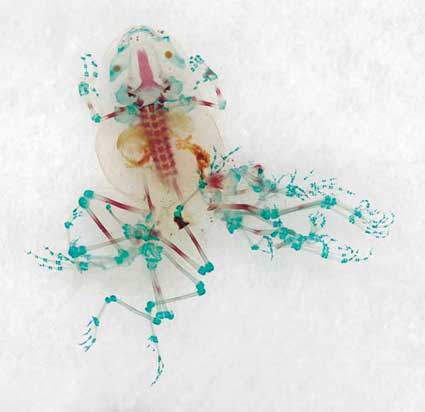
Cleared and Stained American Bullfrog, collected in Brown County, 1954. Photographed July 17, 2001, from the collection of the Hefner Zoology Museum, Miami University, Oxford, Ohio.
I find his work deeply moving for many reasons. One of them has to do with the way he communicates his work. He produces not only amazingly beautiful images of these deformed amphibians but also takes his discourse out of the white walls of art galleries (where aonly a certain category of people will ever get to see them) by taking people to field trips and let them experience first hand what his happening in their own backyards.
The Arts Catalyst has just released a video that documents the project to date:
You can also see some of Brandon’s work at Exit Art in New York in the E.P.A. (Environmental Performance Actions) exhibition through May 17, 2008.
Related: Biorame (part 2) and panel on genetically modified art at the New Museum.
Consolation prize for everyone who missed the sk-interface conference. The videos of the talks -which took place at FACT in Liverpool on February 8 & 9 as part of the sk-interfaces exhibition – have been made available online. Yeah!
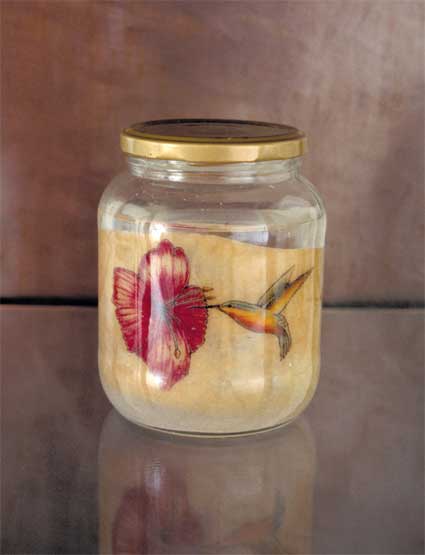
Culture de Peaux d’Artistes by Art Oriente Objet
I’m quoting curator Jens Hauser:
This international conference examined the aesthetic, philosophical and biomedical issues raised in the exhibition. Specialists from a wide range of disciplines and artists of international renown discussed past and future roles of skin, shifts in the concept of interfaces, the emergence of ‘biofacts’ in philosophy, as well as the most contemporary practices of artists using new technologies, biomedia and their own bodies.
Make your way to the FACT archive.
In the order of the conference schedule: Part 1 – Part 2 – Part 3 – Part 4.
The archive also includes footage of the performance Bleu Remix by Yann Marussich, recorded on the opening night of sk-interfaces.
Videos are encoded in H.264 format – you need a recent Flash player.
There’s a also a great catalog with essays, interviews and project presentations: Sk-interfaces: Exploding Borders – Creating Membranes in Art, Technology and Society (Amazon USA and UK.)
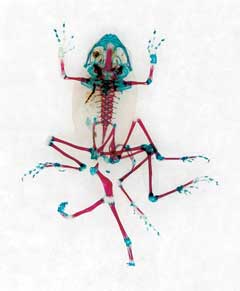 Dear friends and readers living in New York, i’m going to hit your turf soon for a panel rhizome has kindly asked me to set up at the New Museum in Manhattan. If you know me a tiny bit you might have guessed that my first thought was for biotech art. I wasn’t sure my proposal would be accepted as the topic is far less popular than interactive screens in public spaces or “sustainable” gadgetry. It’s a bit more risky as well. But they said yes and i’d love to meet you on Friday 14, at the New Museum theater, 235 Bowery (map).
Dear friends and readers living in New York, i’m going to hit your turf soon for a panel rhizome has kindly asked me to set up at the New Museum in Manhattan. If you know me a tiny bit you might have guessed that my first thought was for biotech art. I wasn’t sure my proposal would be accepted as the topic is far less popular than interactive screens in public spaces or “sustainable” gadgetry. It’s a bit more risky as well. But they said yes and i’d love to meet you on Friday 14, at the New Museum theater, 235 Bowery (map).
The Media Art in the Age of Transgenics, Cloning, and Genomics panel is scheduled at 7,30 pm. There will be the cream of biotech art: Caitlin Berrigan, Adam Zaretsky, Brandon Ballengee, and Kathy High.
If Caitlin doesn’t bring her chocolates, i will bring some yummy chocolate cat tongues from Belgium because we’re having a party after the panel (details about that will follow.)
Image on top left by Brandon Ballengee: Cleared and Stained Multi-limbed Pacific Tree frog, Aptos, California. Digital imaging courtesy The Institute for Electronic Arts, School of Art and Design NYSCC at Alfred University, Alfred, New York.
Last week i flew to one of my favourite cities, Liverpool, to visit the Sk-interfaces exhibition at the FACT art center. The show, curated by Jens Hauser, explores, materially and metaphorically, the concept of skin as a technological interface.
A controversial new exhibition on display in Liverpool showcases real skin tissue in sculptures wrote the BBC news website. Yet every single person i spoke with during the 2 days i spent in the city didn’t seem to find the show controversial. Interesting, surprising, fascinating, challenging, thought-provoking, worth bringing my mum, etc. That’s what i heard but no one i talked to seemed overly shocked nor disturbed.
There is material to cause quite a stir in sk-interfaces but Liverpudlians seemed to be more concerned by the issues brought to light by the artists than by the potentially seditious or “freaky” character of the works on show.
I’ll start the blog visit of this multi-disciplinary exhibition by walking to the second floor of FACT.
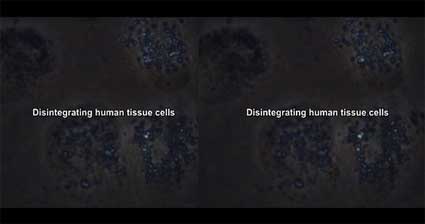
Critical Art Ensemble, Immolation. Image courtesy of the artists
Immolation is a video installation concerned with the subject of the use of incendiary weapons on civilians after the Geneva Convention and the Protocol on Prohibitions or Restrictions on the Use of Incendiary Weapons of 1980. The USA have refused to sign the convention and they make regular use of firebombs in the Middle East. Not because these bombs are the most efficient (they are not), but because they act as moral crushers, tapping on people’s visceral fear of being burned alive.
This video chronicles the major war crimes of the United States involving these weapons on a ( macro) landscape level, and contrasts it with the damage done to the body on the (micro) cellular level.
To accomplish this task, the Critical Art Ensemble (a collective of tactical media practitioners who explore the intersections between art, critical theory, technology, and political activism) grew human tissue at SymbioticA last year, and using high-end microscopy shot the micro footage of skin cells dying by either exploding or imploding. In parallel, CAE shows film footage of present and past wars that have used immolation against civilian targets as a strategic choice for the sole purpose of terrorizing entire populations.
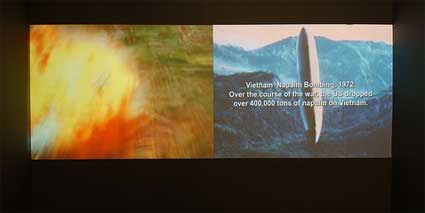
Critical Art Ensemble, Immolation
The result is a video where war crime are shown at both the micro and macro level but which skips the human level. Yet you still manage to view your own body in the narrative. The video is made even more unsettling by the absence of sound, it’s just silence and destruction.
The goal is to provide a different way of imaging, viewing, and interpreting the human costs of these war crimes, in contrast to the barrage of media imagery to which we have become so desensitised. The video portrays what CAE calls an “ecology of crime.”
CAE felt that as long as warfare would be at the center of the Bush agenda, they had to come up with new connections and find venues to show their work (since the arrest of Steve Kurtz some US administrations are feeling the pressure).
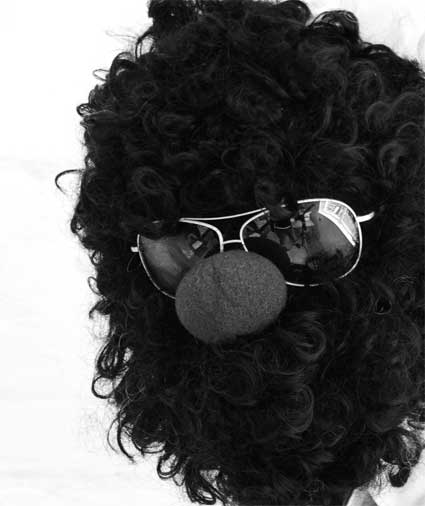
Right next to Immolation, is Truth Serum, a work that responds to the lawsuit against Steve Kurtz and their persecution of Critical Art Ensemble in the USA, which marks an ever-increasing creep of the security state into the nervous system of culture.
For Truth Serum, The Office of Experiments, initiated by Neal White, follows research on serums used historically by official authorities in interrogation processes as a means to obtain information without using torture. The effects of truth drugs were first examined in the 1920’s, and heavily used by the CIA during the Cold War. The present artwork echoes the debate around art’s freedom in the fear and increasing security regime that has emerged after 9/11, while drawing on the cultural history of so-called truth drugs and recent discussions about their use in the interrogation of suspected terrorists.
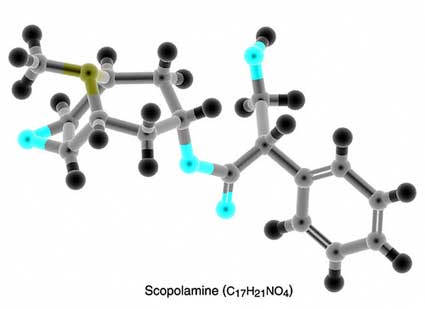
Scopolamine, an ingredient used in truth serums (image courtesy of Neil White)
The use of truth serums is actually illegal but after 9/11 there have been talks (mostly in the press) of using the method again during interrogations by the FBI and the CIA, even though truth serums are more an art than a science.
The installation at FACT combines a space concealed behind a white door and a series of video works that reflect on the aesthetics of terrorist messages, using a dark clown as an anonymous spokesman who reflects on the possibility of carrying out mass self-experimentation with truth drugs as a form of self-defence.
On 29 March 2008, volunteers will be able to participate to the performative part of the Truth Serum installation in support of freedom from artistic censorship.
In a central (and still secret) Liverpool location, participants will willingly submit themselves to a short psychological experiment based on substantiating Truth lasting around 10 minutes. The aim is to probe an atmosphere of paranoia spreading since 9/11.
More information to participate.
My pictures and FACT pictures.
sk-interfaces is on view until March 30 and launches FACT’s Human Futures programme which includes 3 sections – My Body (SK-Interfaces), My Mind and My World, each one hosting a major exhibition, conference and research focus. You can follow its development through Human Futures blog.
Related: They make art not bioterrorism, Jens Hauser’s presentation in Aix en Provence (part 1 and 2.)
Antony Hall‘s projects explore the way we interface with technology, and how our interactions with it influence us creatively and socially. Often collaborating with scientists and technologists, Hall is currently focusing his talent on the investigation of biological and physical phenomenon. Some of his recent experiments involve communication with an electric fish, the creation of life through growing crystals electrically on volcanic stone, hunting for Moss bears and training Planarian worms.
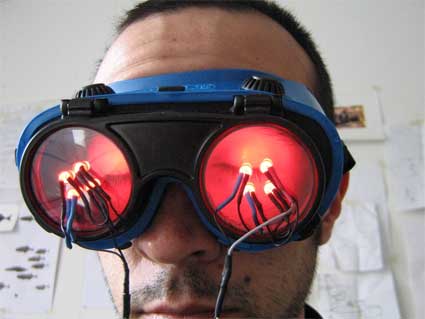
He gained fame in the media and media art festivals with his electro-acoustic sound art devices and performances. Together with Simon Blackmore and more recently Steve Symons, Hall is a founding member of the Owl Project, a group which combines woodwork with electronics to create performances, musical instruments (iLog , and Log1k) and other physical computing projects.
Let’s start with one of your most popular projects: the iLog. How did you get the idea of making it?
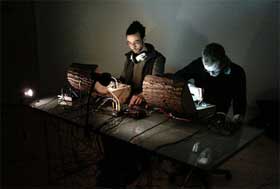 The iLog was created as collaborative project with Simon Blackmore and Steve Symons, we are the Owl Project. We developed the Log1K in 2001 as a performance tool to attempt rival the laptop in electronic music, shortly after this apple started pushing the iPod and we had to make a response, something which related more to the trend for portable, mobile hand held technologies. We wanted our devices to be a synthesis of craft and technology, as well as functional instruments. The Log1ks were getting increasingly heavy, among other things they used nearly 30 AA batteries, short circuits and fires, and blown-out speakers were becoming common place. iLog 01 came out in 2003. After we started collaborating with Steve Symons, we reinvented the electronics inside the iLog and started pushing the whole project to a new level; the M-Log is out later this year.
The iLog was created as collaborative project with Simon Blackmore and Steve Symons, we are the Owl Project. We developed the Log1K in 2001 as a performance tool to attempt rival the laptop in electronic music, shortly after this apple started pushing the iPod and we had to make a response, something which related more to the trend for portable, mobile hand held technologies. We wanted our devices to be a synthesis of craft and technology, as well as functional instruments. The Log1ks were getting increasingly heavy, among other things they used nearly 30 AA batteries, short circuits and fires, and blown-out speakers were becoming common place. iLog 01 came out in 2003. After we started collaborating with Steve Symons, we reinvented the electronics inside the iLog and started pushing the whole project to a new level; the M-Log is out later this year.

There’s now a series of iLog models. Why do you think people buy the iLog? Mainly as a beautiful and quirky piece of art which they would not use too much fearing that it might be damaged (although you provide technical support.)? Or have you found that people use it extensively as any other kind of musical device? Were you expecting your project to have so much success?
I suppose people want the iLog for its quirkiness, something as an alternative to the mass produced items. We had no idea that it would become so popular – people blogged it like mad at the start and like a Chinese whisper it suddenly became what people wanted it to be; typically some kind of alternative to the ipod – But in reality its something quite different. It is intended to be an instrument for performance.
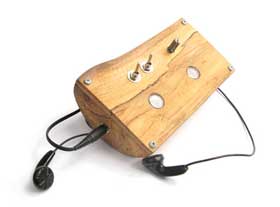
iLog signal
Our problem is that although there is demand; making them is still very difficult, and time consuming, so our focus is making them better rather than faster. At the moment we are looking at lending these to artists and working in collaboration to develop the iLog further. When we launched them for sale in London at DWB it was a real learning curve. Simple things like which way up it should be held, were completely un-obvious! We had to create extensive instructions regarding use, as well as repair and maintenance. The 24 hour support is most necessary! Its important that its more hands on than your average mass produced plastic device.
The iLog is something people can use, rather than living all its life in the art gallery. The new series, *M-Log, launching this year, looks like an iLog, and is a USB connective interface. So there is scope for programming your own sensor based instrument, which you can use with your own customized patch. The iLog is more of a stand alone sound generator. We are planning an event in Manchester during Futuresonic where other performers (including Leafcutter John) will be using the iLogs & M-Logs. *The M in M-Log stands for ‘muio’ as in “muio interface”, the chip based interface inside which Steve‘s invention in his words “The muio interface is a modular system for sensing and controlling the Real World”.
The wood is quite resilient and very repairable if damaged.
I love The Sound Lathe, a performance which explores the sonic properties of wood. Do you have any video of it?
There is some video here:
It does look like a very physical performance. Did you have to master new skills in order to be able to do these performances? How does each performance go? Are they all different from each other? Does working with wood creates situations and results you wouldn’t have expected?
Yes its been really interesting – my self and Simon ended up sleeping in a kind of bivouac deep in the forrest as part or the “R&D” for the project, learning the skills of traditional “green woodwork”, (electricity free) with Mike Abbott, master crafts-person. Mike invented a competition for Bodgers (the name for people who use the ‘pole Lathe’) called ‘Log to Leg’ (as in chair leg) so this is the new format for our performance – I think the record is 9 mins; transforming a bit of tree stump, into two perfect chair legs! It takes us a couple hours, but then our lathe is connected to copious amounts of sensor interface technologies. Quite a distraction, if like for our last performance at Lovebytes, it rained torrentially for the whole thing. In the documentation you will see a tarpaulin underneath that are 3 laptops and Simon.
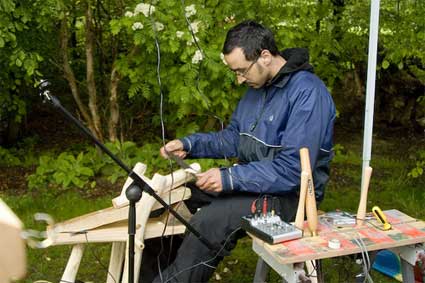
Image Lovebytes
I think for all of us it’s a welcome change from sitting behind a screen the whole time – these physical processes are a great compliment to programming and electronics; and they still require a similar kind of focus and discipline. It is quite exhausting, you need a lot a focus to keep the beat in time as well as make a good carving, in this way it becomes quite mediative. Sharpening the chisels and preparing the timber are all equally demanding skills to learn.
Can you tell us something about the wooden objects produced during the performances? Which kind of objects are there? And what do you do with them once the performance is over?
We have a box full of various objects; ranging in description from ‘chair leg’ to ‘fire wood’, or specialist ‘rolling pin’. Occasionally we have a look inside & discuss what we should do with them. We did make a chair with Mike about the only truly useful thing we ever made. The latest idea is to make some kind of flat pack, or player. Watch this space. You can see what we decide to do with them at The Piemonte Share Festival, 11 – 16 March 2008.
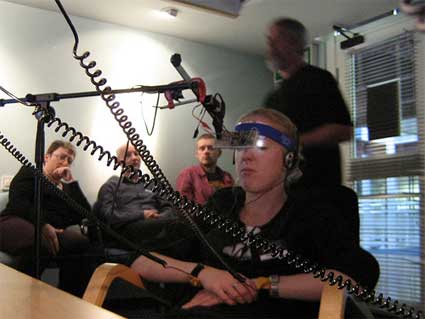
Documentation of first ENKI event at the Museum of Science and Industry Manchester, 7th October 2006
You are also interested in bio-digital medicine. That sounds very different from a project like iLog. Can you explain us what it is and how you started to be interested in this field?
Well this is my own personal project, although I have always working with biology or technological experimentation in some way; with ENKi I decide to humanize what I do. This was a decision to move into medicine and treatment technologies. Really its the same things that we work with in the owl project; looking at how technology is consumed and sold. The notion of bio-digital medicine is just one example in hundreds, of how science, or even the suggestion of science is used, and misused to sell ideas. Faceless corporations feed on our anxieties, our basic need to feel contentment or feel complete. I find it interesting that, just as some people turn to religion, others will look to technology or science to provide answers and solutions.

ENKI uses the bioelectric information from an Electric Fish to trigger human Brain-wave Entrainment. It generates sound and light pulses to induce a state of relaxation similar to the way traditional relaxation systems work, but the electric communication signal comes from an electric fish rather than a chip.
Did you test the system on other people? How do they react?
So far we have tested it on about 40 volunteers,most of them members of the public who had no prior knowledge of the project. We did this in the context of the Manchester Museum of Science and Industry; people enjoy the experience generally. I was surprised at the range of people who were up for it!
By this point I had started working with Greg Byatt as a collaborator. He has experience of using this kind of technology and administering similar treatments professionally. Greg has equipment which can monitor your physiological state and a brain-wave visualiser (EEG); we were trying to measure results this way. We only really came to one solid conclusion. We had to do more tests.
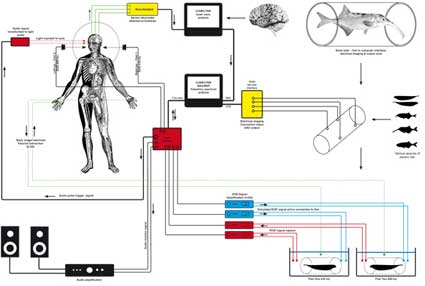
Isn’t the idea of putting one’s “brain-wave entertainment” into the fins of an animal scary? Do you feel that people would trust any other electronic device more than a fish or any other type of animal?
That is a good question. It’s an exciting notion this whole idea of “wet-wear” interfacing – but not something that should be taken lightly. I don’t like to be on my own if i am doing a test run, and yes I find it very unnerving. I never quite got used to the idea of connecting strangers up to electrodes and the fish. I also worry about the fish. The fish needs to be content and ‘happy’ for this to work.
In my opinion that most of these commercial devices are made by various humans all of whom have different intentions and issues, namely cost efficiency; and so effectively using quite crude means; cheap microchips. The Black Ghost knife fish is the result of millions of years of evolutionary refinement; but you could still say the same of micro chips.
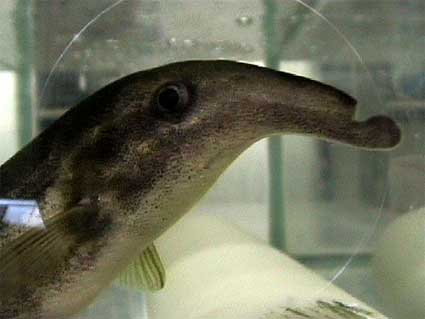
A Down poker
Is that project completely developed or is it still a work in progress?
It’s in progress. I started working with “electrogenic” fish in 2005; ENKI technology was the title I gave it in 2006 when I was in residence at ENSAD in Paris. This was the point I realized I could create a treatment technology that might actually be functional. I had a bit of pressure to actually finish something and so launched the basic concept of ENKI technology. The funny thing was that reflecting on it now – that just marked a new beginning. (It took a year just to convince the director of Pepiniere that it was in fact a real project and not some conjecture in science fiction!). Coming to think of it I have never really finished anything, I am much more excited by the notion of continued experimentation. I don’t want to finish discovering. The more I work on ENKI – the more things there are to do and try, it keeps opening up. There are always more questions.
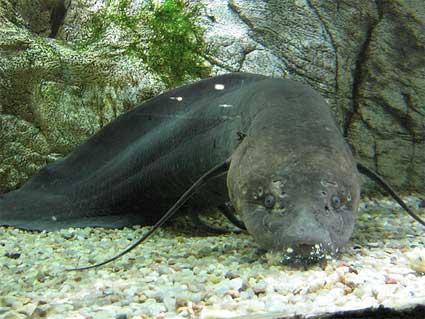
What is there left to achieve? And how much have you learned about cross-species communication?
There is still a lot to achieve. The ‘treatment’ side is just one layer of the onion. I started the project with the aim of communicating with the fish, generating an electrical signal and transmitting this in the fish in the tank, to the fish. Then I watch the the fish, looking for behavioral ‘interactions’ with the electrodes – generally if there is an electrical (connective) change to the electrodes, the fish is aware of this and investigates the electrode by swimming near it and around it (motor-probing responses). I also listening for a ‘chirp’ response. The ‘chirp’ response is a subtle modulation of the Electric signal, a specific fluctuation in the wave. The ‘chirp’ is used during like species interaction and communication. This is closer to the idea of language we have.
Experimentally there are factors which make this difficult to measure – The fish learns to associate the vibrations created by me entering the studio & opening the tank with a food reward. So any approach to the tank needs to be made silently, and the fish needs to be ‘conditioned’ to learn this over a long time. As the project progressed I became more interested in communication as something closer to an idea of commune. For the fish I see the communication signal they make more as a deep expression of self; a projected physical extension of the fish body, rather than ‘language’ in an anthropological sense. This communication is happening at a more primal level. In terms of the ENKi project I am thinking about this as a biological, or physiological connection between living organisms.
I recently discovered that I might be having a problem with what is known as ‘superstitious’ behavior in the fish; if I was a scientist in the academic sense, this would be a serous flaw in the project; something to fix, but for me it was a fantastic turn, giving the project a new angle all together. Its now becoming an experiment into animal Psychology, not just electro physiology. I don’t want to say too much about this next phase but next year the project will look quite different.
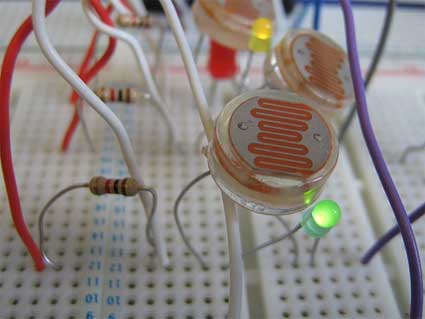
You recently developed the Opto-acoustic modulator and used it for an interactive work at FACT and Liverpool John Moores University for the National Science and Engineering Week. Can you give us more details about this interactive piece? How does it work? What were you trying to achieve with this project?
The commission was to create and interactive art work that used something other than keyborad or mouse. I was determined not to use a video camera either. The the Opto-acoustic modulator basically turns sound-waves into light-waves. It can take 10 audio channels and convert these into “AM” transmissions through 10 Light Emitting Diode arrays. I am fascinated by the notion of ‘Amplitude Modulation’ sending data using light waves. The idea was to use ‘Hyalite’ salt crystals, to broadcast sound through their ‘ionizing’ ambient glow. You interact with the light and can detect the data as sound using wearable sensors. Additionally, using Steve’s ‘muio’ interface again, 8 light sensors detect movement around the crystals using a lens and light sensor (based on the idea a simple biological ‘camera eye’) these feed into MAX MSP controlling a soundscape.
I read on your statement page that you are currently “working on new experiments relating to the creation of life through growing crystals electrically on volcanic stone, hunting for Moss bears (Tardigrades; Fresh water extremophiles) and training Planarian worms. ” Could you already tell us a few words about these experiments?
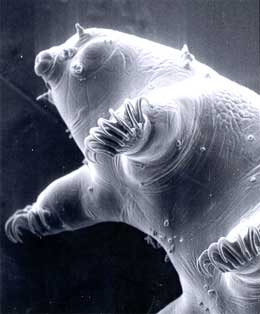
I have been researching the work of William Cross for quite a while, and finally decided that I needed to recreate his experiments (with a few modifications) It’s quite interesting trying to work out what he did – the only way to know is to recreate it. In 1837, he found these creatures “Acari electors” as he called them infesting an experiment, he believed that these things “spontaneously generated” within his experiment, several eminent scientists of the time recreated the experiment with the same results! My experiment is basically a recreation of this experiment, augmented with a little more technology – with the aim of capturing this phenomena of electrochemical abiogenesis. The only problem is the experiment has to run for many months.
I am interested in all sorts fresh water microscopic life; its a great 19h century tradition. With a decent microscope, you can take any roadside moss cluster and explore the interstitial oceans of liquids trapped between damp moss filaments. Here you might be lucky enough to find a Moss Bear ( “Tardigrade” ) an obscure form of extremophile that lives in moss. Believe it or not, it really does look like a bear! This in its self was a reason for laboring days over a microscope just to see if it was real! They don’t fit into the zoological classification system, and have been given a phylum of their own. It is believed it is able to survive space travel, and at this moment a small space capsule orbits the earth containing some “Tardinauts” (its hard to compete with that) I simply enjoy looking for them. I like to go looking for moss growing in all kinds of areas, from urban waste lands, to the Peak District. “Tardigrades” are able to survive about 120 years in a dehydrated state; I was sifting through very old moss samples from Manchester Museum to see if I could reanimate 100 year old dehydrated Moss Bears. apparently it is possible. I had a lot more luck looking for the living ones. Unfortunately my one Planarian worm recently went missing in the tank. It is 8mm long, and I dont have the heart to keep it in a petri dish. I am not sure where it is.
Is there any artist or researcher whose work has been particularly inspiring for you?
I don’t know where to start! Louis Bec for sure. I am really into what SymbioticA have been doing over the past few years, and what they are doing for the “Bio-art” movement. Otherwise, at the moment I am looking at the work of William Bebe. To be honest – I have been trying to read a lot more science fiction lately, particularly 19th century science fiction, and science writing. Often the science fiction tells you a lot about the popular understanding of science at the time. More importantly, its a good antidote ploughing through contemporary research papers.
Thanks Antony!
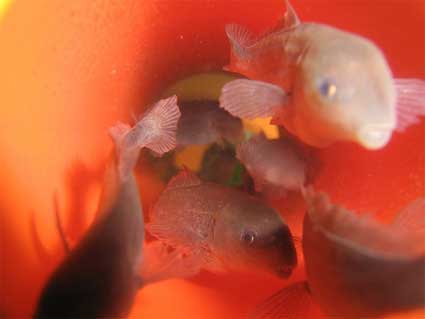
Related: El Niuton has a slideshow dedicated to the work of Simon Blackmore.